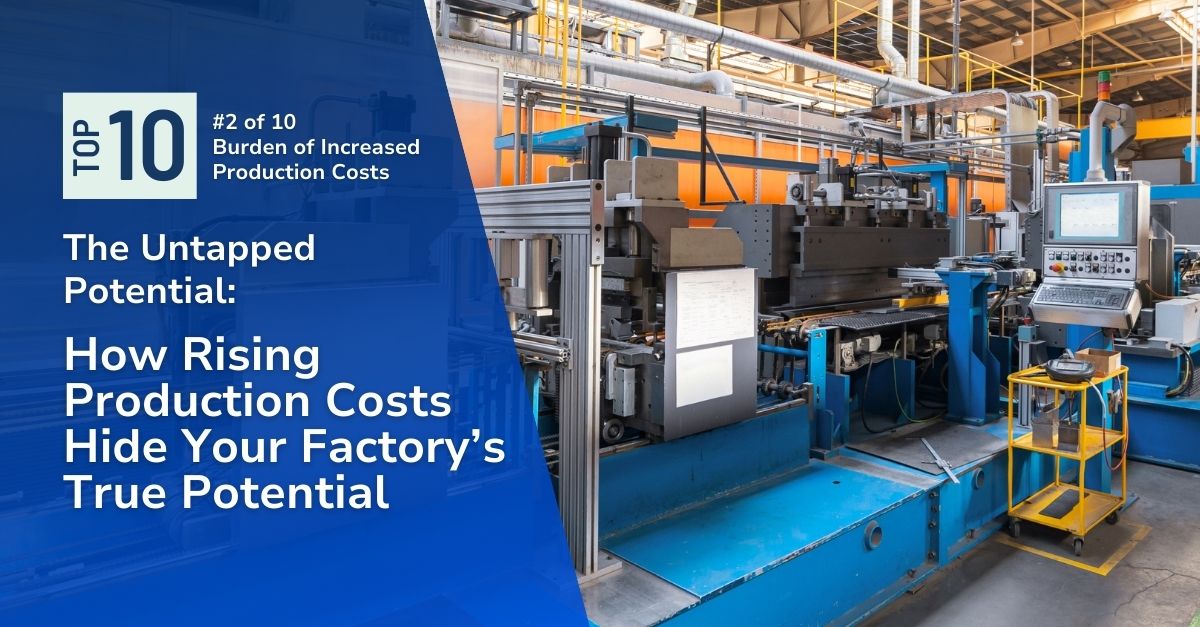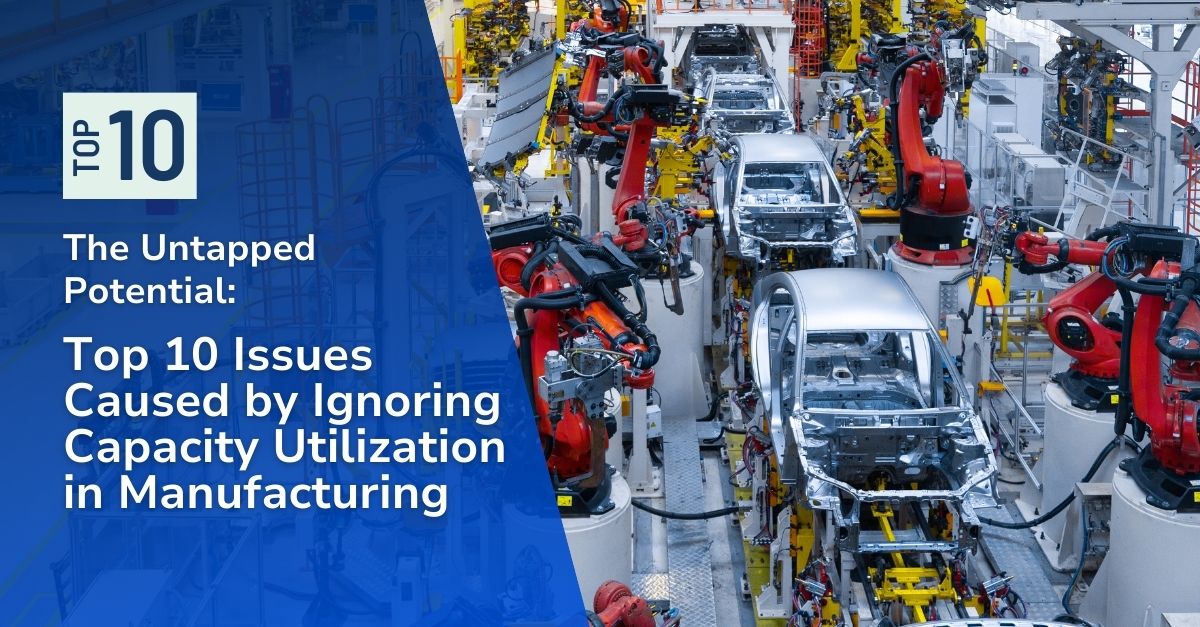
On the shop floor, the squeeze of rising costs is a daily battle. Machines falter more frequently, welds crack under pressure, and frustrated managers scramble to meet deadlines while juggling budget cuts.
Cost-cutting measures feel like the obvious answer, but they often mask an even more significant challenge: your manufacturing facility isn’t living up to its potential. Underperforming capacity utilization is at the root of the problem.
Studies by the Federal Reserve Board show that the average U.S. manufacturing facility operates at only around 78% of its potential capacity.
This underutilization translates to a staggering amount of lost productivity.
Imagine a powerful production line humming with activity, a well-oiled machine churning out products quickly. But instead, a significant portion of that line sits idle, a silent testament to untapped potential. Every idle minute translates to lost production, delayed shipments, and, ultimately, increased costs per unit produced. The burden of rising production costs isn’t just about raw materials or labor – it’s a symptom of a deeper inefficiency: a factory not operating at its full potential. Let’s consider the ramifications.
1 The Substitution Trap:
Negative Impact: Rising input costs tempt manufacturers to use cheaper, lower-quality materials. Yet, inferior materials can lead to faulty components, increased downtime, and damage to brand reputation. Even worse, customers might notice, hurting your standing in the market.
Positive Step: Partner with suppliers for long-term material sourcing strategies. Negotiate discounts or explore alternative materials that balance cost and quality. Prioritize building strong supply chain relationships over chasing short-term savings.
2 Shifting Focus from Customer Satisfaction to Cost Reduction:
Negative Impact: Companies obsessed with cost-cutting often neglect customer desires. This narrow focus results in products or changes that alienate your customer base. You create what’s cheap, not what people want.
Positive Step: Utilize value stream mapping (VSM) to identify and eliminate waste without compromising customer-centricity. Involve cross-functional teams to make cost-saving decisions that align with your brand’s value proposition.
3 Increased Risk of Production Stoppages:
Negative Impact: Cutting corners on maintenance or using sub-standard parts increases machine breakdowns. Unplanned downtime disrupts the entire production flow, causing costly delays and wasted resources.
Positive Step: Implement a predictive maintenance program using IoT sensors and machine-learning to identify potential failure points. This allows for repairs before they become production-halting emergencies.
4 Production Delays and Bottlenecks:
Negative Impact: Machine downtime, material shortages due to cheaper suppliers, and a lack of cross-training lead to bottlenecks. These create a domino effect, disrupting all downstream processes, impacting delivery schedules, and frustrating customers.
Positive Step: Use production scheduling software and bottleneck analysis to optimize production flow. Invest in training to build a multi-skilled workforce for adaptability when problems arise.
5 Difficulty with Inventory Management:
Negative Impact: Inaccurate forecasting due to poor data or lack of demand planning tools leads to overstocking or shortages. Excess inventory ties up capital and warehouse space. Insufficient inventory causes stockouts, disappointed customers, and lost sales.
Positive Step: Invest in a robust demand planning and inventory management system. Use forecasting techniques (consider AI-powered tools) that factor in historical data, market trends, and seasonality. Regularly reconcile physical stock with digital records.
6 Increased Risk of Safety Incidents:
Negative Impact: Rush jobs, overworked employees, poorly maintained equipment, and the pressure to ‘just get it done’ increase safety risks. This can have severe human costs and legal ramifications.
Positive Step: Commit to a zero-incident workplace culture where safety is non-negotiable. Invest in safety training, provide up-to-date equipment, and foster an environment where employees feel empowered to report hazards without fear of retribution.
7 Difficulty Meeting Customer Demand:
Negative Impact: Production delays, material shortages, and quality issues cause a frustrating disconnect between what you promise customers and what you deliver. This strains customer loyalty.
Positive Step: Transparency wins. Communicate proactively about potential delays, offer alternative solutions, and prioritize open dialogue with customers. Use data analytics to understand customer demand patterns and adjust accordingly.
8 Even Higher Losses to Scrappage:
Negative Impact: Cheap materials, overworked employees, and a focus on getting it done quickly cause a spike in rework and scrap. Lost material and labor costs eat away potential profits.
Positive Step: Implement quality control measures throughout the process rather than at the end. Invest in employee training and foster a culture focused on getting things right the first time.
9 Pressure to Do More With Less:
Negative Impact: Staff reductions, budget cuts, and resource shortages put immense pressure on teams. This causes burnout, decreased morale, and ultimately, even higher turnover rates.
Positive Step: Invest in automation wherever possible to alleviate labor-intensive tasks. Explore cross-training initiatives to build a more versatile and flexible workforce
10 Band-Aid Fixes Become The Norm:
Negative Impact: Constant firefighting leaves no time for root cause analysis or long-term sustainable solutions. Temporary fixes compound the problem, leading to future issues.
Positive Step: Shift from a reactive to a proactive mindset. Use tools like the “5 Whys” for root cause analysis. Empower teams to suggest and implement solutions that last.
The Road to Operational Excellence
Increased production costs are a symptom, not the cause. They’re the flashing red light on the dashboard, alerting you to a deeper problem within your manufacturing engine. Underperforming capacity utilization is the culprit – a factory not operating at its full potential. It’s time to look beyond spreadsheets and focus on real-time data to see your operations holistically. Think of it as putting on a new pair of glasses – suddenly, the true cause of lost profits, delays, and stressed-out employees becomes crystal clear.
How POWERS Can Help
At POWERS, we’re passionate about helping manufacturers unlock their operational potential. Our cutting-edge technology platform provides real-time monitoring, detailed analytics, and machine-learning insights, designed to illuminate the hidden inefficiencies plaguing your factory. We help you:
- Identify the root causes of underperforming capacity utilization: Gain a deeper understanding of asset performance and see where production is falling short.
- Optimize production flow and eliminate bottlenecks: Visualize and track your material flow to find where your process slows or stalls.
- Reduce downtime and enhance efficiency: Get proactive alerts on potential machine failures before they cause costly disruptions.
- Empower your teams with actionable data: Give everyone from front-line operators to executives the real-time information needed to make data-driven decisions.
The Bottom Line
Don’t let rising production costs silently sabotage your business. They’re a symptom of a more significant issue – your factory isn’t producing as much as it could. The solution lies in unlocking the actual capacity of your existing assets and eliminating the obstacles that prevent your facility from operating at peak efficiency. Contact POWERS today and let us partner with you on your journey to operational excellence.
Don’t allow lost revenue and eroded profits to cripple your potential. Contact POWERS today for a free consultation and chart a path towards greater profitability and sustainable growth: +1 678-971-4711 or info@thepowerscompany.com.
Sources and Further Reading
Continue Reading from this Mastery Series
- Part 1 – The Price of Lost Revenue and Profit Resulting from Underutilized Capacity
- Part 2 – How Rising Production Costs Hide Your Factory’s True Potential
- Part 3 – Poorly Managing Resources is Stealing Your Profits
- Part 4 – Break the Quality Struggle Cycle to Fix This Shop Floor Frustration
- Part 5 – From Chaos to Capacity: How to Tame Turnover and Optimize Your Operations
- Part 6 – Manufacturing Nightmares: When Your Shop Floor Can’t Keep Up
- Part 7 – When Supply Chain Disruptions Reveal Your True Capacity
- Part 8 – Unlocking Efficiency When Sustainability Meets the Shop Floor
- Part 9 – Understaffed and Underperforming on the Shop Floor
- Part 10 – How Blind Spot Vulnerabilities Impact Your Shop Floor’s Efficiency








